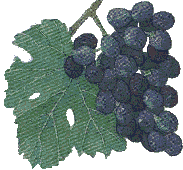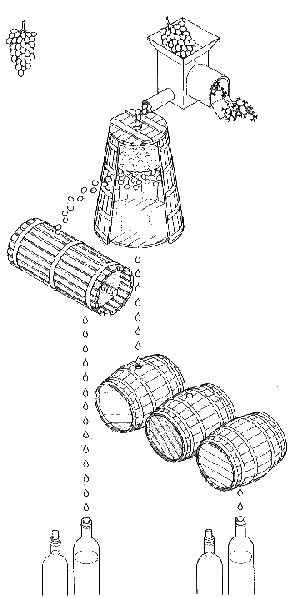- What is wine – the basics
- White wine
- Red wine
- Sparkling, sweet & fortified wine
- Wine and food matching and choosing
- Buying, serving and storing wine
The grape

Tannin also has a taste – slightly bitter – and an effect that dries and puckers the mouth. Another substance containing large quantities of tannin is cold, stewed, strong tea. A mouthful of that will give you an idea of what tannin is all about. The classic red wines of Bordeaux and Burgundy (and their new world counterparts) are made with a hefty dose of tannin that preserves the wine and balances against the other flavour components of fruits, minerals and acids. Such wines are designed to improve over many years until they reach their peak – the point when the tannins have mellowed and the components have integrated perfectly. You need patience, suitable conditions and a healthy bank balance to get into the business of cellaring the great red wines until they reach their peak.
Red wines destined for early or short-term drinking (and not for ‘laying down’) are made with less tannin in their composition. Traditionally these were lesser, peasant wines, made quickly to be drunk with the daily meal and without ceremony. However, tastes and needs change, and many good quality, modern wines are made for immediate consumption. Since these wines don’t need to last several years, the bitter tannins are minimised and the wine tastes fruity, fresh and approachable upon release.
Making red wine
The winemaker has at his disposal a far greater range of techniques, and must make a far greater number of decisions, when making a red wine. The process is essentially the same as the white wine process: gathering the grapes, fermentation, maturation and bottling. At various stages the winemaker can intervene to change the style of the wine he is making.

Most of the great red wines are matured in oak barrels. This is an expensive and labour-intensive process. Oak from ancient French forests is generally agreed to be the finest, imparting a subtle vanilla, toasty flavour and allowing a little micro-oxygenation that can soften the wine. Each 150- to 200-year-old tree produces only 2 barrels, so they are expensive at £750.00 each. The forests are managed with a re-planting policy.
American oak is also very popular and is cheaper. It is regarded as imparting a “bigger”, less subtle, spicy flavour to wine. Oak from the many other countries including Hungary, Croatia and Poland is very old and fine and can be the cheapest of all. Some producers find it is not flavourful enough, whilst for others that is an advantage.
Prior to bottling, the wine must be cleared. Traditional fining is widely practised, but use of filters and centrifuges to remove absolutely all micro-solids from the wine is highly controversial. Wine is a living thing. Tiny biological changes take place over years as the wine matures in the bottle and many people believe that heavy handed filtration destroys the wine’s ability to age and improve. This is why many red wines must be decanted before serving: to run the wine off from solid deposits.
Factors affecting the styles of red wine
The winemaker has a great deal of freedom to make choices in making a red wine. Decisions will be affected by the style of wine the winemaker is aiming to make, and the raw materials the vintage has given. Some of the options open to the winemaker are listed below:
- the vineyards may be planted with a variety different grapes
- varying the proportion of tannic stalks to include in the fermentation
- cold-soaking the grapes – allowing colour and tannin to leach from the skins
- whether to ferment in inert cement or steel, or in oak tanks or barrels
- choosing which strains of yeast to use for fermentation
- choosing the temperature and length of fermentation
- choosing when to remove stalks and skins during fermentation
- choosing how to mature the wine (if in barrel, oak, level of toast, age of barrel, etc.)
- length of maturation (usually between 8 and 24 months)
- whether to add some of the press-wine back in to the blend
- how and when to blend the wines from different grapes and different casks
- choose the method of fining and/or filtration
Special considerations for fine red wines
As well as offering a world of choices to the winemaker, red wine also offers extra challenges and complications that must be overcome to make a great wine.
- balancing the colour and tannin extraction of the wine with its fruit
- how to work the wine during fermentation *
- judging the correct levels of new/old oak and toast level
- how and when the barrels in the cellar are ‘racked’ **
- whether full, partial or no malolactic fermentation is carried out
- decisions on blending, fining and filtration.
* Carbon dioxide given off during fermentation causes the skins to float to the surface of the tank and form a cap. This must be regularly submerged to ensure the wine keeps extracting elements from the skins. This can be achieved by ‘pumping over’ juice from the bottom to the top of the tank, by manually pushing down the cap, or by fitting a mesh filter below the surface of the wine.
** For all the time the barrels are in the cellar the wine must be ‘racked’: wine is drawn from one barrel into a clean barrel. Only around 90% of the barrel is drawn off, the remaining 10% is full of dead yeast cells and is discarded. This process is carried out every 3 months or so and the fresh barrel must be topped back up to 100% with reserved wine
Red wine styles and characteristics
There are just as many flavour profiles amongst red wines as white. Some grapes, like the cabernet sauvignon, take quite easily to a variety of growing conditions, whilst others, such as the pinot noir, seem unhappy anywhere outside their home in Burgundy. A few places are starting to produce credible pinot noirs, notably in cool climates such as Oregon on the northwest coast of the United Sates and on the South Island of New Zealand.
Cabernet Sauvignon – the classic Bordeaux wine grape. A ‘serious’ wine, with intensity and ageing potential which marries very well with the flavour of oak.
blackcurrant, cedar, pencil shavings, peppers, mint, chocolate, tobacco
Merlot – the 2nd great grape of Bordeaux – most Bordeaux is a blend of these 2 grapes along with small amounts of some others. It is a very rich, plummy, spicy grape which lends softness to the sometimes rather serious cabernet.
plums, roses, spice, fruit-cake, blackcurrant, pencil shavings
Pinot Noir – The great red grape of Burgundy. It is a very fragrant and should be silky with heady fruit and sometimes gamy complexity.
raspberries, strawberries, cherries, violets, roses, game, compost, manure
Syrah – the great red grape of the Rhone. Planted outside France it is known as the Shiraz. Huge and complex, rich, spicy and ‘manly’.
raspberries, blackberries, pepper, cloves, spice, leather, game, tar.
Other important red wine grapes include:
Cabernet Franc – green peppers, blackcurrant, leaves, chocolate.
Gamay – the grape of Beaujolais. Many Beaujolais-style wines employ a unique method of fermentation called Carbonic Maceration, or whole berry fermentation, which produces light bodied and coloured wine that is fruity, low in tannin and made for early drinking.
Sangiovese – the grape of Chianti. Full, firm, dry, spicy, tobacco and herbs.
Tempranillo – the grape of Rioja, usually with plenty of spicy, vanilla oak.
Zinfandel – unique to California. Its origins are a mystery, but it is believed to be descended from the Italian primitivo. Full blooded, spicy, powerful, alcoholic.
Red wine tasting terms and descriptors
There are even more words for taking about red wines, largely because red wines can cover such a variety of colours, textures, aromas and tastes. A few examples are listed below:
Austere – tannic; lacking fruit. The wine is too young, or too severe in style
Baked – from a hot climate. Not necessarily bad, but can mean “not fresh”
Coarse – rough and ready – should be cheap
Dense – positive. Solid colour and packed with flavour
Earthy – tastes of earth but can also mean simple and rustic
Finesse – used for wines of high quality, showing a silky and refined nature
Firm – a positive term for a wine with a good balance of tannins and acid
Flabby – not a compliment. The wine is over-oaked, or lacking acidity
Green – raw & un-ripe, often a characteristic of cabernets from poor years
Grip – used as a positive term for young wines with good tannins
Heavy – full bodied and alcoholic, usually means too alcoholic: out of balance
Jammy – not a compliment. Too obviously fruity without great finesse
Meaty – rich & full-bodied, maybe literally with an aroma of meat
Silky – smooth, velvety mouth feel. Usually the sign of a quality wine
Stalky – bitter tannins evident. A fault in some pinot noirs and cabernets
Structure – very positive. Is balanced, well made and will last.
Thin – lacking some flavour and usually some weight in the mouth.
Some descriptive words often used to conjure up the flavours and scents of red wine:
Blackcurrant – along with cedar, the classic Bordeaux/cabernet taste
Cabbage – mature Burgundy. This cabbage smell is a positive aspect!
Coffee – comes from well-integrated oak, associated with top quality wines
Green Pepper – a distinctive note of the two cabernet grapes
Leather – classic shiraz, tough, big, spicy
Liquorice – many full bodied, tannic young wines
Olives – usually slightly under-ripe cabernet sauvignon or cabernet franc
Pepper – Rhone wines are often very peppery on the tongue
Spice – many “big” reds, including Rhone, zinfandel and Rioja
Strawberry – Beaujolais & lighter Burgundy
Tar – a heady, rich wine, probably from a hot climate
Tobacco – a lovely rich, warm taste from good Bordeaux
Vanilla – oak ageing
On to Wine Course Part IV – Sparkling, sweet and fortified wine

